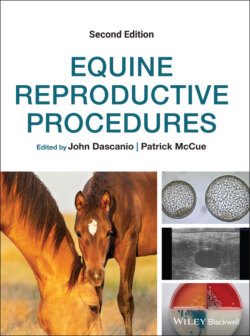Читать книгу Equine Reproductive Procedures - Группа авторов - Страница 94
Additional Comments
ОглавлениеOverall, flushing the oviducts provides diagnostic information on oviductal patency and at the same time often provides therapeutic intervention in affected mares. In regard to the latter, it has been suggested that removing oviductal masses via the normograde approach may be more difficult compared with the retrograde approach, as the luminal diameter of the isthmus is significantly smaller than the ampulla.
A concern for all the approaches discussed is the need to provide significant pressure during the flush to successfully relieve blockage(s) without rupturing the oviduct. It may be possible to reduce the risk by systemic administration of N‐butylscopolammonium bromide and/or local application of prostaglandin E2 gel onto the surface of the oviduct or the UTJ prior to the flush.
To avoid this risk of rupture of the oviduct altogether, the purely therapeutic option of applicating PGE2 to either the oviductal surface or the UTJ (without first checking oviductal patency) can also be considered in mares suspected of having oviductal issues (see Chapters 30 and 31).
